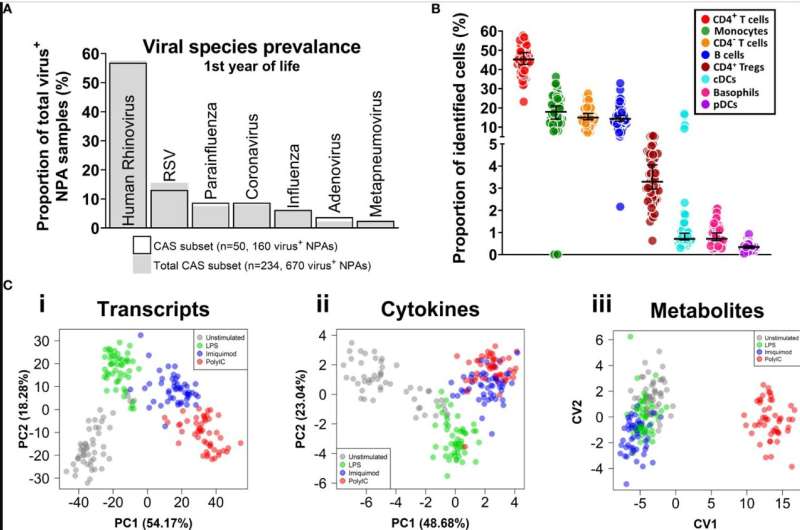By better predicting asthma risk, preventive treatments could bypass disease development

Two University of Arizona Health Sciences scientists are one step closer to developing a predictive test to assess a baby's risk for asthma, which would allow parents to take steps to thwart the disease's development and could guide doctors to prescribe preventive treatments. The research was recently published in Frontiers in Immunology.
Anthony Bosco, Ph.D., is an associate professor of immunobiology and associate research scientist with the Asthma and Airway Disease Research Center, sees opportunity. "The first 1,000 days of life shape how the immune system develops in response to the outside world," said Anthony Bosco, Ph.D., associate professor of immunobiology in the UArizona College of Medicine—Tucson and associate research scientist with the Asthma and Airway Disease Research Center. "There's a window of opportunity to go in there with interventions that can strengthen the immune system and reduce the risk of asthma."
Asthma is an inflammatory disorder in which the airways narrow as they become inflamed, making it difficult to breathe.
Dr. Bosco and James Read, a data scientist with the Department of Immunobiology and the Asthma and Airway Disease Research Center, studied 50 babies at high risk for asthma and found that those who went on to develop asthma exhibited an exaggerated inflammatory response after being exposed to certain pathogenic, or disease-causing, bacteria.
Investigators studied the unusually intense immune response and identified a likely driver: a network controlled by a gene called Interferon Regulatory Factor 1 or IRF1.
"The internet is a bunch of information that's connected through web links. Gene networks work in much the same way," Dr. Bosco said. "If gene A interacts with gene B, we connect it with a link, constructing a 'wiring diagram' of hundreds of genes that control the immune response."
The researchers saw that the "wiring" of the IRF1 gene network in children who develop asthma is different than in children who do not develop asthma.
They believe that conditioning the body to pathogenic bacteria at an early age could "reprogram" the immune systems in asthma-prone children to respond more appropriately to asthma-attack triggers, such as fungi, dust mites and viral infections.
"Our research suggests you can minimize asthma risk by treating the immune system in a way that avoids this excessive inflammatory response," Dr. Bosco said. "Our long-term goal is to roll out a predictive test at scale, start testing babies to predict their risk, and put them on therapies that promote a healthy immune system."
The investigators believe training a baby's immune system through exposure to certain microbes may be the key to reducing their risk of developing asthma. They are hopeful that at-risk babies can overcome their genetic predisposition to asthma through controlled exposure to bacterial extracts that have been weakened to make them safe to administer to babies and young children.
"If your exposure to bacteria happens early on and you develop a healthy microbiome, the way your immune system responds to pathogens will be more fine-tuned," Dr. Bosco said. The microbiome is the community of bacteria and other microbes that take up residence in the body, where they mostly live in symbiosis.
The investigators believe they can potentially bypass the need for lifelong asthma medications by giving at-risk children microbial products that can train the immune system. Microbial products are already being studied for their ability to reduce asthma risk, including at the Asthma and Airways Disease Research Center, where Fernando Martinez, MD, is principal investigator of the ORBEX trial to measure the efficacy of bacterial extracts in preventing asthma-like symptoms.
In addition to using microbial products, Read says a test revealing babies' faulty genetic wiring can motivate parents to make healthier choices for their children.
"If parents are informed that their child is more likely to have asthma, they can make changes, like monitoring time outside during certain periods of the year, such as when outdoor airborne fungal spore concentrations are at their highest levels in spring," Read said. "Our work is moving away from the reactive, where you wait until a disease is present and treat it, to an earlier timepoint where we can take actions to reduce risk and lower disease burden."
More information: James F. Read et al, Lipopolysaccharide-induced interferon response networks at birth are predictive of severe viral lower respiratory infections in the first year of life, Frontiers in Immunology (2022). DOI: 10.3389/fimmu.2022.876654


















